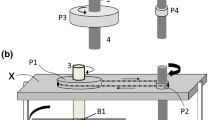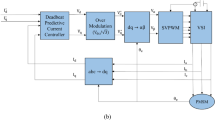Abstract
An analysis of the results of methods of controlling switch-induction motors are described. Switch-induction motors were shown to be motors with alternating, a priori unknown parameters. Control of these motors using microprocessor systems and digital sensors leads to time delays that result in brake torques and decreasing power characteristics of motors that limit the torque at high rotating frequencies. Ways and methods of solving this problem are determined.
Similar content being viewed by others
References
Brodovskii, V.N. and Ivanov, E.S., Privody s chastotnotokovym upravleniem (Drivers with Frequency-Current Control), Moscow: Energiya, 1974.
Kholodnokatannye elektrotekhnicheskie stali: Spravochnik (Cold-Rolled Electric Steels. Handbook), Molotilov, B.V., Ed., Moscow: Metallurgiya, 1889.
Shabaev, V.A. and Alyakrinskii, V.E., USSR Inventor’s Certificate no. 149041.
Shabaev, V.A., Criteria of Technical-Economical Optimum of Switch-Induction Motor Application, Russ. Electr. Eng., 2008, no. 4, p. 207.
Shabaev, V.A., Noise Sources in a Switched-Reluctance Motor, Russ. Electr. Eng., 2005, vol. 76, no. 5, p. 69.
Additional information
Original Russian Text © V.A. Shabaev, 2011, published in Elektrotekhnika, 2011, No. 7, pp. 8–12.
About this article
Cite this article
Shabaev, V.A. Peculiarities of controlling switch-inductor motors. Russ. Electr. Engin. 82, 348–351 (2011). https://doi.org/10.3103/S106837121107008X
Received:
Published:
Issue Date:
DOI: https://doi.org/10.3103/S106837121107008X




